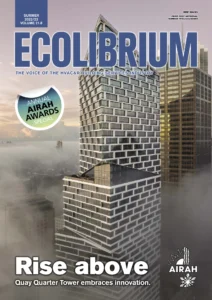Questioning convention

There is a growing chorus that now, perhaps more than ever, institutionalised professions need to question conventional practices in response to evolving public need.
Within the context of the HVAC industry, the COVID‑19 pandemic has highlighted some gaps in the conventional approach to ventilation design. Despite best intentions, conventional design has been shown to be inadequate in mitigating against the risk of airborne disease transmission such as the SARS‑CoV‑2 virus.
In the days and weeks following the World Health Organization’s declaration of a worldwide pandemic caused by the novel coronavirus in March 2020, the reaction from the Australian HVAC industry, while swift, was cemented in well‑established conventions.
Existing ventilation systems were modified in an attempt to reduce the risk of infection transmission, and early recommendations centred on increasing outside air ventilation rates and filtration efficiency within existing air handling systems.
What was missing, however, was analysis of how effective these strategies might be during a one‑in‑100‑year pandemic.In seeking to better understand how the risk of disease transmission within buildings could be reduced through improved HVAC design, multidisciplinary engineering firm Stantec embarked on a collaborative research project with leading academic institutions and advisory groups.
“When we first started workshopping with researchers in this field, it became evident that there was a disconnect between the academic community and industry on what are the most practical means for addressing this problem,” says Patrick Chambers M.AIRAH, Australian mechanical discipline leader for Stantec Australia.
“The early advice being advocated was to increase ventilation rates. However, the interpretation of what that actually means was not consistently understood. In some definitions it was implied that higher ventilation rates equated to higher supply‑air flow rates, not specifically to the percentage of outside air in the supply air.”
Unpacking the journey of a respiratory droplet through the ventilation system very quickly revealed a large gap in the established literature.
“We wanted to know whether droplets survive the journey through ductwork reticulation systems,” Chambers says. “And if so, to what extent is this influenced by the complexity of the ductwork distribution network?”
The subsequent investigation into the effectiveness of different ventilation system configurations in clearing aerosols from indoor spaces has had a profound impact. Rather than side with convention, it has led Chambers and his colleagues to challenge the industry to focus on the most effective HVAC strategies.
Nominated as a Finalist at the 2022 AIRAH Awards, a research project has investigated the effectiveness of pandemic-mode HVAC strategies. The findings flip the conventional management of airborne disease transmission in buildings on their head.
Creating connections
Commencing in early 2020, the project was led by Chambers and combined the in‑house expertise of mechanical engineers William Garbett, Affil.AIRAH, and Steven Armstrong, along with computational fluid dynamics (CFD) engineers Daniel Lansell and Corey Lab.
Investing about $150,000 into the research, Stantec sought collaboration from academic partners at the University of Queensland (UQ), and Queensland University of Technology (QUT), including Professor Lidia Morawska.
“A key part of our contribution to the research has been in applying computational modelling methods to simulate typical HVAC system configurations in a number of realistic scenarios, and testing the sensitivity to various parameters,” says Chambers.
Using CFD modelling software, respiratory aerosol release was simulated based on experimental results that characterise the exhalation volume and droplet size distribution for various respiratory activities.
Typical realistic scenarios were built within the model, including a 100m² office space and a 16‑bed hospital ward, both based on real project examples. The latter scenario was studied using funding from the Australasian Healthcare Infrastructure Advisory group, with input from QUT.
“Ventilation system configuration and capacity for the base simulations were based on the actual designs,” says Chambers, “typically representative of minimum compliance.”
Alternative ventilation system configurations were then explored, modelled and simulated. These included changes to key parameters such as outside air percentage, in‑duct droplet recirculation rate, and location of supply/return air diffusers.
Displacement ventilation systems were also measured against ceiling/mixing systems and various scenarios including local/portable air purifiers.
In ‑duct droplet decay factor was defined as a percentage of suspended droplets that deposit within the ductwork and air handling system between the return air.
There was recognition that the size and quantity of aerosols released from different respiratory activities vary significantly.
Four distinct size “modes” were classified from a previous investigation by QUT’s Professor Morawska of size distribution of droplets produced during different respiratory activities.
Ranging from <0.8 to 5.5 microns, these droplet sizes were used to establish standard profiles within CFD software for breathing, talking softly, talking loudly and coughing. These respiratory activities were then applied to the realistic scenarios, based on observations of typical office and hospital environments.
Using CFD analysis, the simulation was able to investigate the relative fate of aerosols ejected by these activities under the various ventilation settings.
The parameters tested included varying levels of recirculated outside air and varying rates of droplet survival when recirculating through duct systems. In total, 22 different ventilation system configurations were simulated and quantitatively assessed against a number of benchmarks.“
The key assessment criteria proposed to relate to minimising the risk of disease transmission,” Chambers says, “is the reduction in quantity (mass) of suspended aerosol particles over time.”
The paradigm shift in thinking proposed by this research starts with considering that people are pollution sources
A targeted approach
The key finding from this modelling is that ventilation system design should focus on stopping respiratory aerosols from becoming completely mixed within an indoor environment. This can be achieved by bringing the exhaust/return grilles closer to the source of exhaled breathe.
Such an outcome is somewhat ironic given one of the key assumptions made in the commonly studied Wells‑Riley model of the airborne transmission of infectious diseases is that air inside the room is well‑mixed (i.e., respiratory aerosols rapidly become uniformly distributed in the air).
“Our research highlights that what we should be trying to achieve is to stop respiratory aerosols from becoming completely mixed within an indoor environment,” says Chambers.
“The paradigm shift in thinking proposed by this research starts with considering that people are pollution sources, and that a fundamental tenet of ventilation design is that local exhaust systems aimed at capturing pollution close to the source are far more effective in reducing pollution spread within buildings than increasing dilution rates.”
This principle applies to most scenarios where pollution sources are localised in buildings – including kitchens, bathrooms, laboratory chemical stores and the like.
Consequently, the research has determined that designers of ventilation systems must consider a shift from traditional ceiling‑mounted return/exhaust grilles to local exhaust/filtration systems installed as close as possible to where respiratory activities are taking place.
This likely includes integration of such systems within furniture and/or other fixed building elements.
“The research has shown that strategically targeted local exhaust and filtration systems effectively clear respirator aerosols from indoor environments significantly more effectively than increasing ventilation rates,” Chambers says.
Additionally, the study found a distinct lack of academic and industry discussion surrounding the phenomenon of in‑duct droplet decay, which calls into question the effectiveness of increased ventilation rates.“
It is the opinion of the authors that perhaps what is being missed in the mainstream industry recommendation to increase outside air percentage is the concept that if aerosols are significantly decaying within recirculated ductwork infrastructure, there is limited benefit to increasing outside air percentage when considering suspended aerosol content,” according to the study.
“If respiratory droplets do not survive the journey between a return air and supply air diffuser, there is no sensitivity to increasing ventilation rates,” says Chambers.
“The industry focus needs to be on targeted suction/exhaust, not supply.”
Chambers says results from modelling have been workshopped in various forums, including with aerosol physicists, mechanical ventilation engineers and architects.
“It is generally supported across all academic and industry domains by a common‑sense acknowledgement that exhaust capture of respiratory aerosols is very likely the best way to deal with airborne disease transmission in buildings,” he says.
Resilience
Professor Lidia Morawska’s ARC-funded research project “Making Australia Resilient to Airborne Infection Transmission”.
It is applying its computational fluid dynamics (CFD) modelling to address the research question of “how to improve the effectiveness of ventilation by optimising airflow in existing spaces and future designs, considering personal ventilation solutions and emerging technological designs”.
Representation
The research results and the concept of localised exhaust systems have been presented in a number of forums both locally and internationally, including:
- Australian Healthcare Week 2021
- European Healthcare Design Conference 2021
- International Health City Design Conference 2021
- International Indoor Air Conference 2022
- Canadian Healthcare Engineering Society Conference 2022
- AIRAH Future of HVAC 2022
“The general feedback has been very positive,” says Stantec’s Patrick Chambers, M.AIRAH. “And we have witnessed somewhat of a ‘light-bulb’ moment when people come to terms with the fact that our exhaled breath is, in effect, indoor air pollution, and that gaseous pollution is most effectively dealt with via localised capture.”
New concepts
Although the research proposes a localised exhaust/filtration design that challenges engineers and designers to consider how industry moves to a decentralised filtration model, it has also highlighted a gap in available technology.
This technology is what the project has termed “micro‑ventilation”.
Chambers says the biggest obstacle to its adoption is the lack of availability of an off‑the‑shelf product that engineers can currently specify.
“Due to the small nature of these systems, they are not easily designed in the way we specify traditional, larger ventilation system components,” he says. “For example, the fan and filters are much smaller than those available from typical suppliers.”
Other challenges include acoustic performance, and the bespoke filter sizes required for replacement during service and maintenance.
As part of further research funded by the Australasian Healthcare Infrastructure Advisory group, the effectiveness of localised “micro‑ventilation” systems in clearing aerosols from buildings is being tested.
Chambers says this is an internationally significant concept that has attracted global attention – the findings of which have been presented both locally and internationally throughout 2021 and 2022 (see breakout above).
Working with a Queensland‑based manufacturer, prototype “micro‑ventilation” systems have been developed. Various configurations of fans, filters and sensors have been tested to establish a solution that provides the best combination of airflow, filtration efficiency, spatial size and acoustic performance.
Stantec is also investing in the development of digital tools to provide a mechanism for integrated smart sensor technology to automate the operation of these products to optimise effectiveness.
In the next phase of the research, the team will investigate the effectiveness of this concept in various applications including schools and public transport hubs, and test the optimum requirements in terms of filtration efficiency, airflow, UV sterilisation performance and product distribution.

This article appears in Ecolibrium’s Summer 2022-23 edition
View the archive of previous editions
Latest edition
See everything from the latest edition of Ecolibrium, AIRAH’s official journal.




